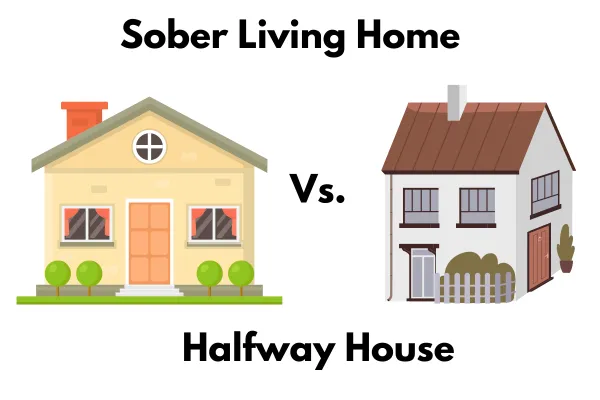
The Difference Between Sober Living and Halfway Houses
When navigating the path to long-term recovery, understanding your housing options is crucial for making the right choice for your sobriety journey. Two of the most common transitional housing options are sober living homes and halfway houses, but many people don't realize the significant differences between these two types of recovery housing.
If you're considering your next steps after treatment or looking for a supportive environment to maintain your sobriety, this guide will help you understand which option might be the best fit for your recovery goals.
What is a Sober Living Home?
A sober living home is a residential facility that provides a structured, alcohol and drug-free environment for individuals in recovery. These homes serve as a bridge between inpatient treatment and independent living, offering residents the support and accountability they need while maintaining their freedom and autonomy.
Key Features of Sober Living Homes:
Voluntary participation - residents choose to live there
Peer-led house meetings and support systems
House rules focused on maintaining sobriety and personal responsibility
Flexible length of stay based on individual needs
Employment and educational opportunities encouraged
Regular drug and alcohol testing
Structured daily routines and curfews
24/7 sober living environment
What is a Halfway House?
A halfway house is a government-funded residential facility primarily designed for individuals transitioning from incarceration back into society. While some halfway houses also serve people in recovery from substance abuse, their primary focus is on reintegration after prison rather than addiction recovery specifically.
Key Features of Halfway Houses:
Court-ordered or mandated placement in many cases
Government funding and oversight
Stricter rules and regulations
Time-limited stays (usually 6-12 months)
Focus on job placement and societal reintegration
More institutional atmosphere
Limited personal freedom and autonomy
Emphasis on compliance with legal requirements
The Major Differences
1. Purpose and Focus
Sober living homes are specifically designed for addiction recovery and maintaining sobriety. The entire environment is crafted to support individuals who have completed treatment and want to continue their recovery journey in a supportive community.
Halfway houses primarily focus on helping formerly incarcerated individuals reintegrate into society. While they may have substance abuse components, recovery is not their primary mission.
2. Entry Requirements
Sober living homes typically require:
Completion of a treatment program or detox
Commitment to sobriety
Ability to pay rent and fees
Willingness to follow house rules
Halfway houses often require:
Court mandate or parole requirement
Recent release from incarceration
Compliance with legal obligations
Meeting government eligibility criteria
3. Length of Stay
Sober living homes offer flexible stays that can range from a few months to over a year, depending on individual needs and progress in recovery. Residents can typically stay as long as they're benefiting from the environment and following house rules.
Halfway houses usually have strict time limits, often 6-12 months, regardless of individual progress or needs.
4. Cost and Funding
Sober living homes are typically privately funded, with residents paying rent and fees. This can range from $500-$2,500 per month depending on location and amenities.
Halfway houses are usually government-funded, with minimal or no cost to residents, but this comes with more restrictions and oversight.
5. Level of Freedom
Sober living homes offer greater personal freedom while maintaining structure. Residents can work, attend school, maintain relationships, and make personal choices within the framework of house rules.
Halfway houses have more restrictive rules about movement, visitors, employment, and daily activities, reflecting their role in the criminal justice system.
Which Option is Right for You?
Choose a Sober Living Home if:
You're focused primarily on addiction recovery and maintaining sobriety
You want a supportive peer community of others in recovery
You value personal freedom within a structured environment
You can afford the monthly costs
You want flexibility in your length of stay
You're looking for a stepping stone to independent living
Choose a Halfway House if:
You're transitioning from incarceration and it's court-mandated
You need government-funded housing assistance
You're comfortable with more institutional-style living
You have legal obligations that require this type of facility
You need intensive structure and oversight
The Benefits of Sober Living Homes for Recovery
Sober living homes offer unique advantages for individuals focused on substance abuse recovery:
Community Support
Living with others who understand the challenges of recovery creates a powerful support network. Residents often form lasting friendships and accountability partnerships.
Gradual Transition
The structured yet flexible environment allows for a gradual transition to independent living, reducing the risk of relapse that can come with too much change too quickly.
Continued Recovery Focus
Every aspect of the home environment is designed to support sobriety, from house meetings to recreational activities to peer support.
Employment and Education Opportunities
Residents are encouraged to pursue work, education, and personal growth opportunities while maintaining their recovery focus.
Red Flags to Watch For
When evaluating either option, be aware of these warning signs:
Lack of clear rules and structure
No drug testing protocols
Overcrowded conditions
Lack of qualified staff oversight
No emergency procedures
Poor maintenance or unsafe conditions
Unclear fee structures
No recovery programming or support
Making the Right Choice for Your Recovery
The decision between a sober living home and a halfway house depends on your specific circumstances, needs, and recovery goals. Consider these factors:
Your primary reason for seeking transitional housing
Your financial situation and funding options
Your legal obligations, if any
Your preference for structure vs. freedom
Your timeline for transitioning to independent living
Your support system and recovery network
The Path Forward
Whether you choose a sober living home or a halfway house, the most important factor is finding an environment that supports your recovery goals and helps you build the foundation for long-term sobriety. Both options can be valuable stepping stones when chosen appropriately for your specific situation.
Remember that recovery is a personal journey, and what works for one person may not work for another. Take time to research your options, visit facilities, and speak with staff and residents to make an informed decision.
Ready to Take the Next Step in Your Recovery Journey?
If you're looking for a supportive, recovery-focused environment that prioritizes your sobriety and personal growth, Trinity House offers the structured yet flexible sober living experience you need. Our experienced team understands the unique challenges of transitional housing and is committed to helping you build a strong foundation for lasting recovery.
Don't wait – your recovery deserves the right environment.
Contact Trinity House today to learn more about our sober living programs and how we can support your journey to long-term sobriety. Call us now or visit our website to schedule a consultation and take the first step toward a brighter, sober future.
Trinity House Sober Living LLC https://trinityhouse.info | 425-474-3210
Your recovery is our priority. Let us help you succeed.
